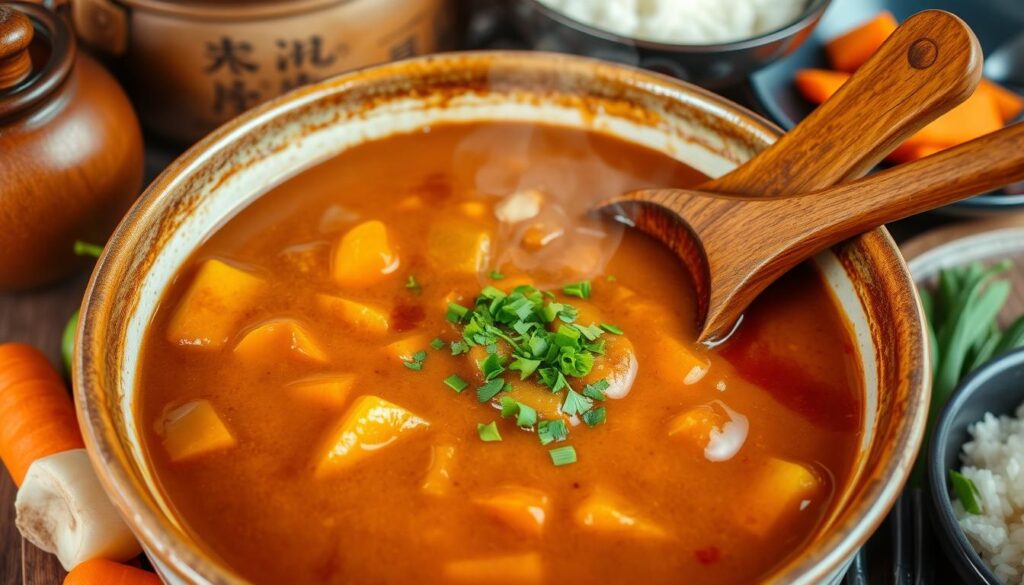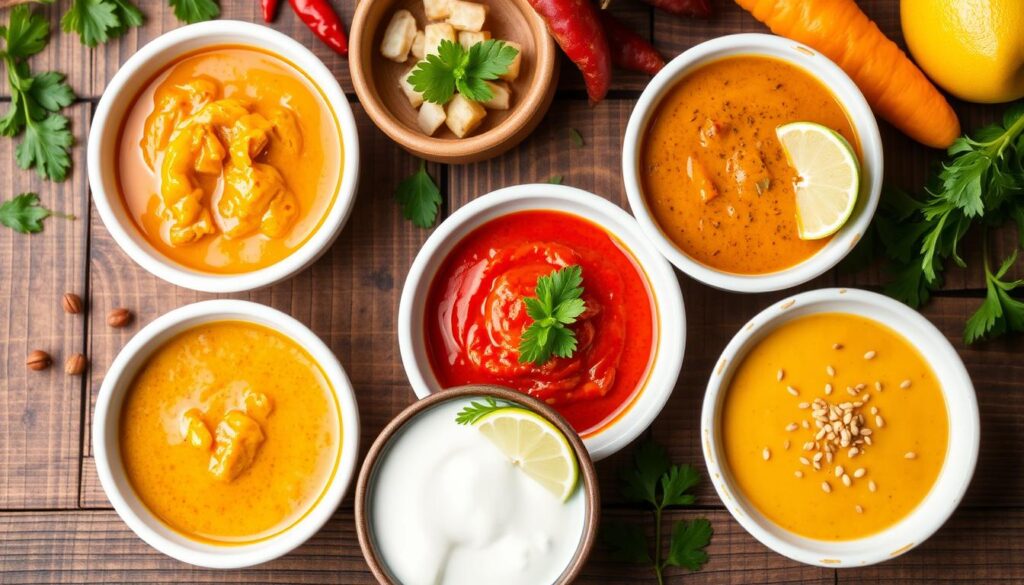Have you ever tried Japanese katsu curry? It’s a mix of crispy breaded cutlet and rich curry sauce. This combo is a culinary delight that excites your senses. As a home cook, I’ve worked hard to make this dish perfect in my kitchen. Today, I’m sharing my easy recipe for homemade katsu curry sauce. It’s a taste of Tokyo in every bite.
Katsu curry is loved by many for its comforting flavors. It’s a mix of crunchy breaded cutlet and a deep, complex curry sauce. The best part? It’s ready in just 30 minutes. This makes it perfect for quick weeknight meals or casual get-togethers.
Understanding Japanese Katsu Curry Sauce
Katsu curry sauce, also known as tonkatsu sauce, is a Japanese twist on Western barbecue sauce. It has grown into a versatile curry sauce. It started as a dip for breaded pork cutlets, or tonkatsu, but now it’s a favorite comfort food in Japan and worldwide.
Origins and Cultural Significance
The history of katsu curry sauce goes back to Japan’s Meiji period. This was when Western food first came to Japan. The tonkatsu, a breaded pork cutlet, became a hit. The katsu curry sauce was the perfect match, adding a savory and sweet touch to the crispy meat.
What Makes Katsu Sauce Special
Katsu curry sauce stands out from other curries like Indian or Thai ones. Japanese curry is milder and sweeter. It’s thick and gravy-like, making it great with rice for a cozy meal.
Difference from Other Curry Sauces
Japanese curry is different because it’s based on a roux with spices like cumin and coriander. It also has turmeric and garam masala. The addition of onions, carrots, and potatoes makes it unique compared to other curries.
“Katsu curry, a Japanese export, is extremely popular in England and features regularly on restaurant menus there.”
Essential Ingredients for Perfect Katsu Curry Sauce Recipe
Making authentic Japanese katsu curry sauce at home is a fun journey. The secret to great flavor is knowing the key ingredients. Let’s dive into what makes this sauce so special.
The core of katsu curry sauce includes curry powder, turmeric, garlic, and ginger. For a true taste, use S&B Foods curry powder, loved by many in Japan. You’ll also need onion, flour to thicken, and a mix of stock and coconut milk for creaminess.
To enhance the flavor, add soy sauce or tamari (for gluten-free) and a bit of sweetness with grated apple or tomato puree. This mix of flavors makes katsu curry sauce unique.
| Ingredient | Quantity |
|---|---|
| Oil | 2 tablespoons |
| Onion, diced | 1 medium |
| Garlic, minced | 3 cloves |
| Ginger, grated | 1 tablespoon |
| Curry powder | 3 tablespoons |
| Turmeric | 1 teaspoon |
| Flour | 3 tablespoons |
| Chicken or vegetable stock | 1 cup |
| Coconut milk | 1 cup |
| Soy sauce or tamari | 2 tablespoons |
With these katsu sauce ingredients, you can make a katsu curry sauce from scratch. It will take you straight to the heart of Japanese cooking. Next, we’ll look at the kitchen tools you’ll need to make this sauce.
Kitchen Equipment You’ll Need
To make the perfect katsu curry sauce recipe, you need some key tools. Here’s what you’ll need to whip up this tasty Japanese dish:
Essential Tools
- A large saucepan or Dutch oven for cooking the sauce
- A sharp knife for chopping the vegetables
- A whisk for mixing and blending the sauce
- Three shallow dishes for the flour, egg, and breadcrumbs when breading the katsu
- A meat mallet or rolling pin to flatten the meat
Optional Equipment for Better Results
While the basic tools are a must, some extra gear can make things easier. Here are some options to help you get the best katsu curry sauce recipe:
- A food processor or blender to create a smoother sauce consistency
- An immersion blender for pureeing the sauce directly in the pot
- An ice cube tray for freezing individual portions of the sauce for later use
With these tools and equipment, you’re ready to make a delicious katsu curry sauce recipe in your kitchen.
Step-by-Step Preparation Method
Making a tasty easy katsu curry sauce from scratch is easy and rewarding. Start by cooking onions, garlic, and ginger in oil until they’re soft. Then, add curry powder and turmeric, followed by flour to make a roux.
Slowly add chicken stock, coconut milk, and soy sauce, whisking all the time to avoid lumps. Let the sauce simmer for 5-10 minutes to thicken. For a smoother sauce, blend it with a stick blender after cooking.
To make katsu (breaded proteins), first coat the meat or vegetables in flour, egg, and panko breadcrumbs. Fry them until they’re golden, then bake to cook them through.
- Sauté onions, garlic, and ginger in oil until softened.
- Add curry powder and turmeric, then stir in flour to create a roux.
- Gradually pour in chicken stock, coconut milk, and soy sauce, whisking continuously.
- Simmer the sauce for 5-10 minutes, allowing it to thicken.
- Optionally, blend the sauce using a stick blender for a smoother consistency.
- Coat the meat or vegetables in flour, egg, and panko breadcrumbs.
- Fry the breaded proteins until golden brown, then bake to ensure thorough cooking.
- Serve the katsu with the homemade katsu curry sauce and cooked rice.
This whole process, including making the katsu, takes about 30-40 minutes. By following these simple steps, you can make a katsu curry sauce from scratch that’s just as good as your favorite Japanese restaurant.

| Ingredient | Amount |
|---|---|
| Chicken Breasts or Thighs | 2 |
| Plain Flour | 25g |
| Eggs | 1-2 |
| Panko Breadcrumbs | 50g |
| Butter | 25g |
| Onion, diced | 1/2 |
| Mild Curry Powder | 2 tbsp |
| Chicken Stock | 60ml |
| Light Soy Sauce | 1 tbsp |
| Mirin | 2 tbsp |
| Cornflour/Water | 1 tbsp/1 tbsp |
| Salt and Pepper | to taste |
| Vegetable Oil | for frying |
| Cooked Rice | for serving |
Tips for Achieving the Perfect Consistency
Making the perfect katsu curry sauce recipe needs careful attention to its consistency. Start by adding liquids to the roux slowly, whisking constantly. This helps avoid lumps. If the sauce is too thick, add more stock or water to get the right texture.
Troubleshooting Common Issues
If the sauce is too thin, simmer it for a bit longer. Or, mix in a cornstarch slurry to thicken it. For lumps, whisk or blend the sauce until it’s smooth.
Texture Adjustments
- The sauce should be thick enough to coat the back of a spoon.
- For a creamier sauce, use more coconut milk.
- Add honey or sugar to adjust the sweetness.
Getting the perfect katsu curry sauce consistency takes practice. But with these tips, you’ll soon make a smooth, flavorful sauce. It will make your homemade Japanese dish even better.
Flavor Variations and Customizations
Discover the full potential of homemade katsu curry sauce with different flavors and customizations. Whether you prefer spicy, sweet, or vegetarian options, this Japanese dish can be made just for you. It’s all about tailoring it to your taste.
For a spicy kick, try using medium or hot curry powder instead of mild. The S&B Golden Curry Mix adds a richer flavor. For more heat, add cayenne pepper or your favorite hot sauce.
Want a milder version? Use vegetable stock for vegetarian katsu curry sauce. This change makes it perfect for those who follow a plant-based diet. For a vegan katsu curry sauce without curry powder, mix turmeric, cumin, coriander, and garam masala.
For a sweeter taste, add grated apple or a bit of honey. To improve texture, chop bell peppers or grate carrots. They add crunch and color.
This recipe is all about trying new things. Find the flavor mix that excites you the most. Make katsu curry sauce your own!

Storage and Reheating Guidelines
Keeping your homemade katsu curry sauce fresh and tasty is key. With the right storage and reheating tips, you can enjoy it for days. This ensures you get to savor its delicious flavors over and over.
Proper Storage Techniques
For the best taste, store leftover sauce in an airtight container in the fridge for 3 days. If you want to keep it longer, freeze it in portions using ice cube trays or freezer bags. This way, you can enjoy it for up to 3 months.
Reheating Instructions
- If you froze the sauce, thaw it in the fridge overnight before reheating.
- When you’re ready to reheat, put the sauce in a saucepan. Warm it over low heat, stirring now and then.
- If it’s too thick, add a bit of water or stock to get the right consistency.
- Or, you can reheat it in the microwave. Just stir it often to heat it evenly.
By following these easy storage and reheating tips, you can enjoy your homemade katsu curry sauce for days or even weeks. It becomes a handy and versatile part of your cooking routine.
Serving Suggestions and Pairings
Make your homemade katsu curry sauce even better by serving it with crispy breaded chicken, pork, or fish. This creates a classic Japanese katsu curry dish. Serve it over steamed white rice or coconut rice for a real Japanese taste.
For those who don’t eat meat, the katsu curry sauce is great with breaded tofu, tempura veggies, or roasted veggies. It’s also perfect as a dip for fries or fresh veggies.
To round out your meal, add pickled veggies or a light salad. For a heartier option, try it with udon noodles or a Japanese potato salad.
| Serving Suggestions | Pairing Options |
|---|---|
|
|
The homemade katsu curry sauce has a rich, savory, and slightly sweet taste. It’s a great addition to your cooking. Try different ways of serving it to find your favorite.
Conclusion
Homemade katsu curry sauce is a delicious addition to your cooking. It has a rich flavor and creamy texture, perfect for Japanese dishes at home. This sauce can be made to fit different diets and tastes.
It’s great with traditional katsu or in new dishes. This sauce will quickly become a favorite, bringing Japan’s flavors to your table.
The sauce’s mix of savory, sweet, and spicy flavors is amazing. Making it at home is easy with the right ingredients. It’s perfect for impressing anyone, whether you’re an experienced cook or new to Japanese food.
Homemade katsu curry sauce is not just quick to make. It lets you customize the flavors to your liking. You can try different proteins and spice levels. Enjoy the rich flavors of Japanese curry and make your cooking more exciting.










